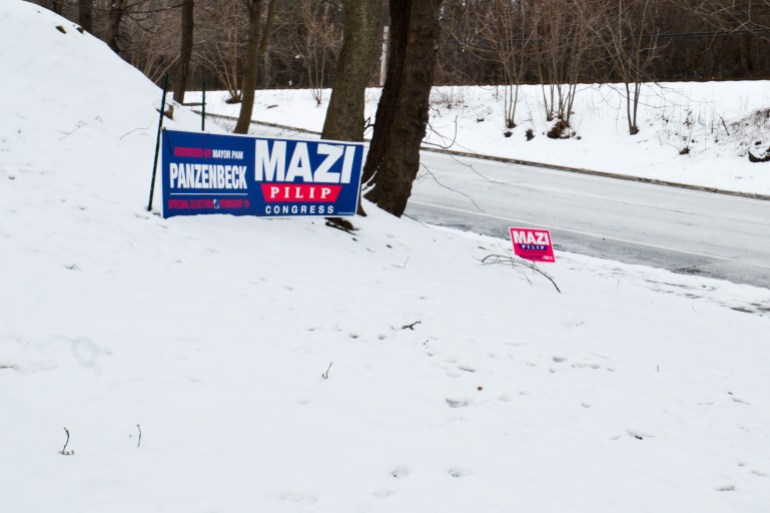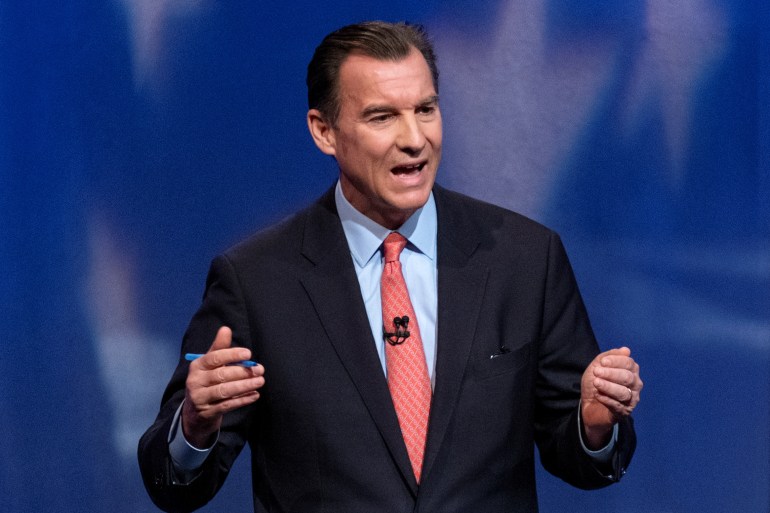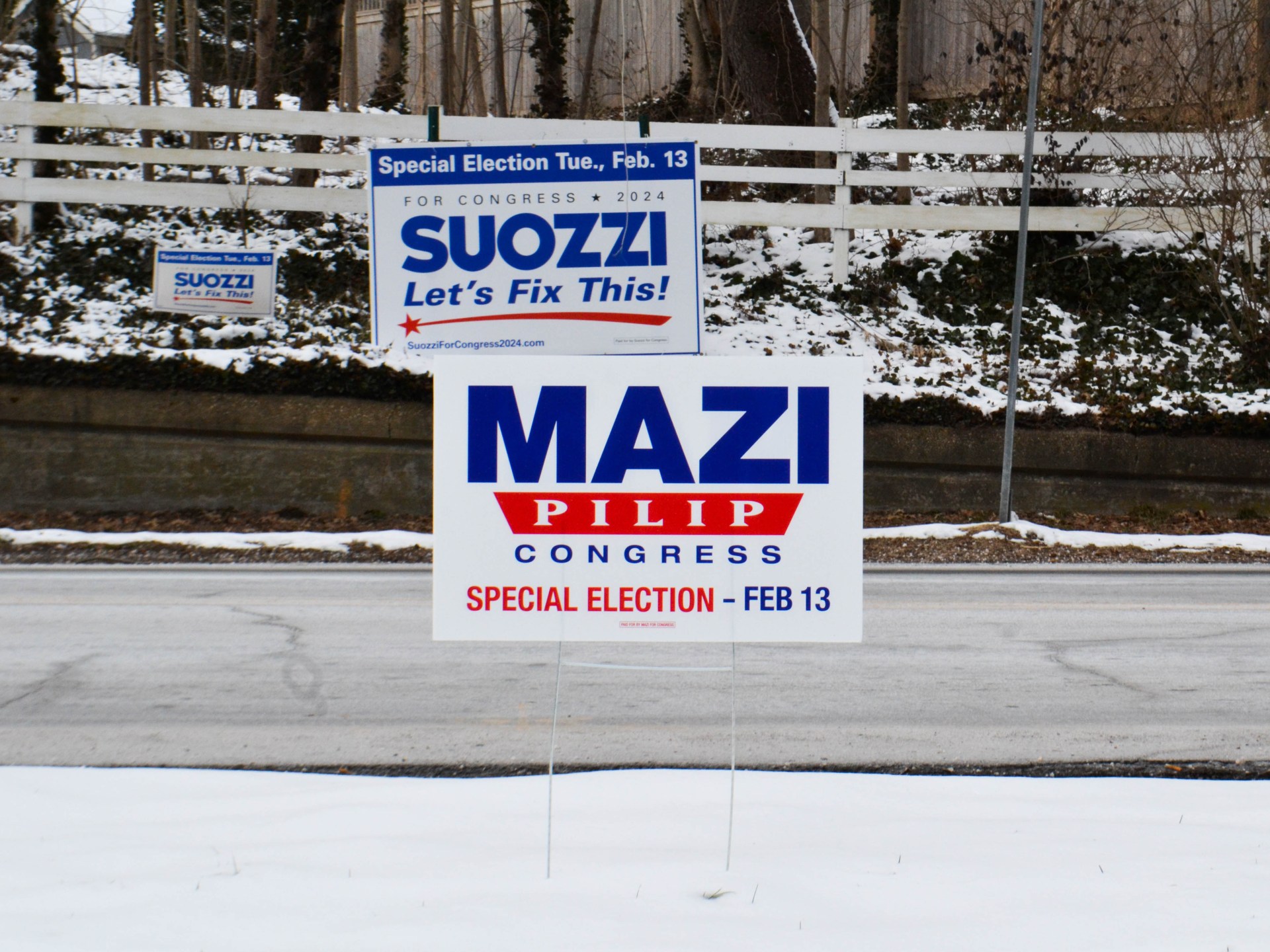In New York, a head-to-head House race foreshadows national elections | US Election 2024 News
Glen Cove, New York – Mansions rise from the coastline. Sailboats clip the waves. And overlooking the landscape, atop a grassy hill, sits the house of a former president, Theodore Roosevelt.
Nestled on the north shore of Long Island, New York’s third congressional district is the wealthiest in the state — and recently, it has emerged as a key battleground for control of the United States House of Representatives.
On February 13, all eyes will be on the district as it holds a special election to fill its House seat, left vacant after the expulsion of former Representative George Santos.
But the stakes go beyond a single district. Experts say the race can be seen as a preview for the general elections on November 5, when the presidency and every seat in the House will be up for grabs.
“February 13 is really about November 5 in a lot of suburbs around the country, not just this one,” said Lawrence Levy, associate vice president and executive dean at the National Center for Suburban Studies at Hofstra University.
“Both parties see this as a bellwether to test strategies and tactics and messages — to see how they deal with various minefields they’re facing.”
For Democrats, Levy dubbed those political minefields “the three I’s”: immigration, inflation and Israel. For Republicans, one of the primary hurdles is the issue of abortion, he said.
Republicans ‘can’t afford to lose a seat’
To tackle those issues, control over the House of Representatives is critical. Republicans currently hold the most seats in the House — though their lead is razor thin and declining.
The party occupies 219 seats, down from 222 at the start of last year. At least two Republicans have resigned in the interim, and another left to grapple with cancer.
With Democrats holding 212 seats, the House is vulnerable to a shift in party leadership. Any district that flips — or changes party — during the upcoming election could help tip the balance of power towards the Democrats.
Levy said races like the one in New York’s third district could prove pivotal. He pointed out that, to pass its current House agenda, Republicans need every vote they can muster to overcome Democratic opposition. Even a small degree of party dissent can stymie legislation.
“They can’t afford to lose a seat even now,” Levy said, “particularly when there are Republicans who are looking out for their own skin in their own competitive suburban districts.”
Those Republicans, Levy explained, “might be inclined to make a deal with Democrats to maintain the image of being a moderate” in order to boost their individual election prospects — even at the expense of party priorities.

A history-making campaign, up in flames
New York, therefore, is one of several states where both Republicans and Democrats are hoping to make gains this year in their House membership.
Though New York state leans Democratic overall, its more localised House races can be volatile: Experts said at least seven of the state’s 26 House districts could see nail-biter elections this November.
District 3 is one of them. In 2022, the district made national headlines with its surprise election of Santos, a political newcomer and the first openly gay Republican non-incumbent elected to the House.
He was part of a miniature red wave in Long Island, where two seats were wrested from the Democrats’ grasp. He credited his victory to the power of grassroots campaigning.
“The one thing I’m proud of is I can prove that there is diversity of thought in this country. Just because you’re gay does not mean you have to be a Democrat,” Santos told the public radio station WNYC, speaking to his historic victory.
But even before he took office, Santos became mired in controversy, as allegations emerged that he had lied about his education, his work history and even his religion.
“I said I was Jew-ish,” he said in a New York Post interview acknowledging his Catholic faith.
Santos was ultimately booted from the House in December, after an investigative subcommittee said it had uncovered “substantial evidence” that he had committed crimes.

The veteran versus the outsider
Republican Party leaders have sought another political outsider to replace Santos: Mazi Melesa Pilip, an Ethiopian American and former paratrooper for the Israeli military.
In December, the publication Politico reported that Pilip — who campaigns as tough on immigration and crime — has been a registered Democrat since 2012. It described the race as “destined for drama”.
Democrats, meanwhile, put forward Tom Suozzi, an Italian American political veteran who held the House seat before Santos. He is considered a familiar face in Long Island politics.
Levy described the Democrats’ choice as safe — and an appeal to the middle ground.
“Democrats went with a local name brand that was actually known around the state: someone who had held the office. So he’s got a record, which can be a plus or minus,” he said.
Long Island voter Debbie Rocco, 70, is among those familiar with the Suozzi family name. A lifelong resident of Glen Cove, a small waterside town, she said the Democrat has hometown appeal. He has lived in the quiet cluster of suburbs for years.
“Everybody in Glen Cove knows Tom,” Rocco said. “I worked with him, because I used to be involved with a charity in Glen Cove, and he’s been the mayor here.”
But Rocco added that just because she knew Suozzi did not mean she was enthusiastic about voting for him. “He’s the lesser of two evils at this point,” she said.
Levy, meanwhile, indicated that Pilip’s nomination might be designed to lure voters away from the Democratic Party.
“[Pilip] is an Orthodox Jew who has served in the Israeli military,” Levy said. “She might appeal to some Jews who normally would vote Democratic.”

Gaza war a leading issue
Standing outside her snow-covered home, Rocco and her longtime friend and housemate Susan Corbo, 68, described themselves as independent voters. Rather than following party lines, they said they vote by issue.
“Besides abortion”, Corbo said she was particularly concerned about continued access to “social security and Medicare and Medicaid”, the latter two of which are government health insurance programmes.
“They want to take that away from us,” Corbo explained.
She and Rocco also pointed to Israel’s war in Gaza as another critical issue driving them to vote in the February special election.
Both Pilip and Suozzi have been vocal supporters of Israel amid its months-long military campaign in the Palestinian territory. More than 27,900 Palestinians have died since the war began on October 7, prompting international concern about the possibility of genocide.
A former Israeli soldier, Pilip has made backing Israel a cornerstone of her candidacy, a position popular among Republicans. But Levy pointed out that Suozzi is in a more delicate position.
The Democratic base is split over whether Israel’s war is justified — and whether a ceasefire should be called. A February poll from the Associated Press and the NORC Center for Public Affairs Research found that 50 percent of US adults felt Israel had “gone too far”.
But President Joe Biden and other top Democratic leaders have thus far refused to demand a ceasefire, alienating progressive members of their own party.
As Suozzi attempts to balance opposing views within his own party, Levy said he faces a situation similar to Biden’s.
“The war in Gaza is a particular problem for the Democratic candidate,” he said. “President Biden and Suozzi’s support for Israel has the potential of turning off some younger voters who have expressed concerns about the way the Israeli army has conducted their offensive.”
In that way, February’s special election could even forecast Biden’s re-election prospects.
“This race has been nationalised and even internationalised,” Levy said.

Money flows into district race
That heightened public attention has translated into an outpouring of money in the race, as each party angles to notch a high-profile victory.
According to data from the Federal Election Commission, which maintains a public record of campaign contributions and spending, Pilip’s team has raised a total of about $1.3m since December 2023.
Suozzi’s campaign, meanwhile, has raised about $4.5m in recent months — more than triple what Pilip has brought in.
Gara LaMarche, former president of the liberal donor network Democracy Alliance, said the numbers are telltale signs of today’s campaign fundraising climate.
“Politics has become more than ever like sports,” LaMarche said. “A lot of people are paying close attention to these races, and a lot of people give directly to campaigns.”
LaMarche describes the campaign contributions as a symptom of a rising awareness among Democrats that their seats in Congress could be vulnerable.
It’s caused somewhat of an awakening among largely Democratic states, LaMarche said, following the loss of Democratic seats in past elections. Currently, all four House seats in Long Island are Republican-held, as opposed to a 50-50 split just two years ago.
“One of the reasons Republicans have control of the House is because, in the blue states, people weren’t paying enough attention to these House races,” he said.
He cites cases of gerrymandering, a practice of manipulating district maps to favour a particular party, in states like New York and California as a flaw in past Democratic strategy.
In states “where there is Democratic hegemony”, LaMarche said, “Democrats were too greedy with gerrymandering.” In 2022, for instance, New York’s highest court struck down redrawn districts thought to have heavily favoured Democrats.
In December, the court allowed the Democrat-controlled legislature to take a second shot at recalibrating the map for House districts, sparking Republican concern for 2024. Gerrymandering is barred under state law, but deciding what qualifies can be tricky.
The ongoing battle to draw New York’s House districts — and the heated race in Long Island — are both part of an overall phenomenon of widening party polarisation, LaMarche said.
That phenomenon is relatively new, he added. “The two parties in this country were not as ideologically polarised as they are today.”
Check out our Latest News and Follow us at Facebook
Original Source






